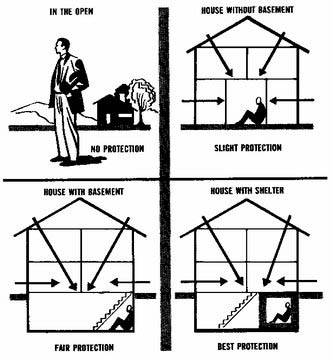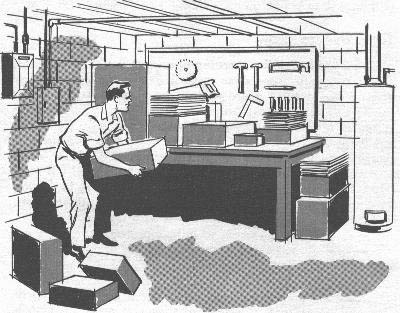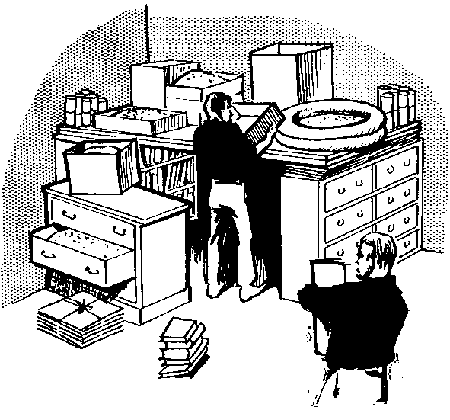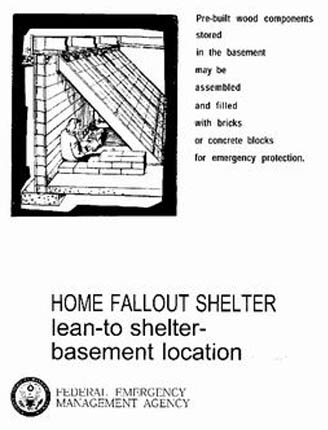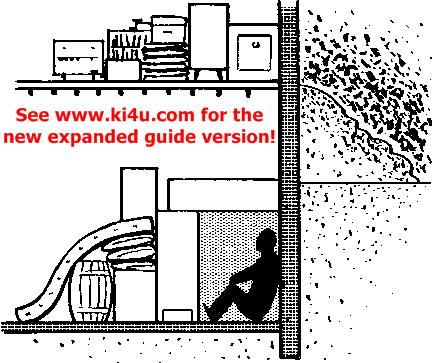|
PDF version for best printed copy is here http://www.ki4u.com/guide.pdf
IF you can do so quickly, e-mail the link to this page
to all on your e-mail list... Your top priority right now, though, is preparing for your own immediate family survival!
WHAT TO DO IF A NUCLEAR DISASTER IS IMMINENT!
This guide is for families preparing for imminent terrorist or strategic nuclear attacks (If attack NOT imminent, then first go read The Good News About Nuclear Destruction!)
In a national crisis of imminent nuclear weapon attacks, read all the way through this guide first, THEN TAKE EFFECTIVE PROTECTIVE ACTION, BEFORE THEY STRIKE, WITH CONFIDENCE... FAST!
#1 - STAY OR GO? You must decide FIRST if you need to prepare where you are, or attempt evacuation. The nature of the threat, your prior preparations, and your confidence in your sources of information should direct your decision. If you know already you will be preparing to stay at your own home or, at least, the immediate local area, go now to #2 below.
If you are considering evacuation, your decision requires very high confidence that it is worth the risk. You do not want to get stuck between your current location and your hoped for destination, as there will probably be no easy moving forward or getting back. If you fail to get to your destination, you may be exposed without shelter, in a dangerous situation, perhaps among panicked hordes of refugees. Whatever supplies you have may be limited then to what you can carry on foot. IF you are in a big city or near a military target, AND you have relatives or friends in the country or sufficient resources, AND the roads between you and them are clear, AND the authorities are not yet restricting traffic, AND you have the means and fuel, evacuation may be a viable option for a limited time. DO NOT attempt evacuation if all of the above is not clearly known, or if the situation is deteriorating too quickly to assure the complete trip. You do not want to get stuck and/or become a refugee being herded along with panicked masses. If evacuation is truly a viable option, do not wait - GO NOW! Do so with as many of the supplies listed in #7 as possible. Better to be two days too early in arriving than two hours too late and getting snagged mid-way, potentially exposing your family to a worse fate than having stayed where you were. Because of the very real danger of getting caught in an evacuation stampede that stalls, almost all families will be better off making the best of it wherever they currently are.
#2 - WHAT YOU NEED TO DO FIRST Because time is of the essence, you need to first delegate and assign to different adult family members specific tasks so they can all be accomplished at the same time. Your first priorities to assure your family survival are Shelter, Water, and Food/Supplies. While some are working on the water storage and shelter at home, others need to be acquiring, as much as possible, the food and supplies, if stores not already besieged.
#3 - FOOD/SUPPLIES Because much of the food and supplies listed at #7 of this guide may quickly become unavailable, you need to assign someone NOW to immediately go to the stores with that list! Get cash from the bank and ATM's first, if it can be done quickly, but try and use credit cards at the stores, if at all possible, to preserve your cash.
#4 - WATER With one or more adults now heading to the stores with the list at #7, those remaining need to begin storing water IMMEDIATELY! Lack of clean water will devastate your family much more quickly and more severely than any lack of food. Without clean water for both drinking and continued good sanitary practices in food preparation and for bathroom excursions (which could become less sanitary than normal), debilitating sickness could rampage through your family with little hope of prompt medical attention. That is a likely but, avoidable, disaster, ONLY IF you have enough water.
Every possible container needs to be filled with water RIGHT NOW! It will be very hard to have stored too much water. When the electricity/pumps go down or everybody in your community is doing the same thing, thus dropping the water pressure, what you've got is all you might be getting for a very long time. Empty pop bottles (1-3 liter) are ideal for water storage, also filling up the bathtub and washing machine. (Remember, later you'll have some in your hot water tank.) If you have any kiddie pools or old water beds, pull them out and fill them up, too. (Water from a water bed should be used only for bathing or cleaning, not for drinking as it may contain traces of algaecide and/or fungicides.) Anything and everything that'll hold water needs to be filled up quickly RIGHT NOW!!
One of the shopping items listed at #7 is new metal garbage cans and liner bags which you'll also use for storing water. If you can't get any more new cans, you could clean out an existing garbage can, then put in a new garbage bag liner and fill it with water. Even sturdy boxes and dresser drawers could be used with bag liners. Choose well where you fill up garbage cans with water because they won't easily be moved once full and many of them together could be too heavy for some upper floor locations. Ideally, they need to be very near where your shelter will be constructed and can actually add to its shielding properties, as you'll see below. BE ASSURED, YOU CANNOT STORE AND HAVE TOO MUCH WATER! Do not hesitate, fill up every possible container, RIGHT NOW!
#5 - SHELTER The principles of radiation protection are simple - with many options and resources families can use to prepare or improvise a very effective shelter. You must throw off any self-defeating myths of nuclear un-survivability that may needlessly paralyze and panic, and then seal the fate of, less informed families.
Radioactive fallout is the particulate matter (dust) produced by a nuclear explosion and carried high up into the air by the mushroom cloud. It drifts on the wind and most of it settles back to earth downwind of the explosion. The heaviest, most dangerous, and most noticeable fallout, typically dark grit, will 'fall out' first closer to ground zero. It may begin arriving minutes after an explosion. The smaller and lighter dust-like particles will typically be arriving hours later, as they drift much farther downwind, often for hundreds of miles. Once it begins to arrive, whether visible or not, all that will fall will usually do so in about an hour, coating everything, just like dust does on the ground and roofs. However, rain can concentrate the fallout into localized 'hot spots' of much more intense radiation with no visible indication.
This radioactive fallout 'dust' is dangerous because it is emitting penetrating radiation energy (similar to x-ray's). This radiation (not the fallout dust) can go right through walls, roofs, windows and clothing. Even if you manage not to inhale or ingest the dust, and keep it off your skin, hair, and clothes, and even if none gets inside your house, the radiation penetrating your home is still extremely dangerous, and can injure or kill you inside.
Radioactive fallout from a nuclear explosion, though very dangerous initially, loses its intensity quickly because it is giving off so much energy. For example, fallout emitting gamma ray radiation at an initial rate over 500 R/hr (fatal with one hour of exposure for 50%) shortly after an explosion, weakens to only 1/10th as strong 7 hours later. Two days later, it's only 1/100th as strong, or as deadly, as it was initially.
That is really very good news, because our families can readily survive it IF we get them into a proper shelter to safely wait it out as it becomes less dangerous with every passing hour.
What reduces radiation, and thus protects your family, is simply putting distance and mass between them and the radiation source. Like police body armor stopping bullets, mass stops (absorbs) radiation. The thicker and heavier the mass, the more radiation it stops, and the more effective it is with every inch more you add to your fallout shelter. The thickness in inches needed to cut the radiation down to only 1/10th of its initial intensity for different common materials is: Steel 3.3", concrete 11", earth 16", water 24", wood 38". The thickness required to stop 99% of the radiation is: 5" of steel, 16" of solid brick or hollow concrete blocks filled with mortar or sand, 2 feet of packed earth or 3 feet if loose, 3 feet of water. (BTW, lead is nothing special, same as anything else pound for pound.) You may not have enough steel available, but anything you do have will have mass and can be used to add to your shielding - it just takes more thickness of lighter wood or books, for example, than heavier earth, to absorb and stop the same amount of radiation. Increasing the distance between your family inside and the radiation outside also greatly reduces the radiation intensity.
The goals of your family fallout shelter are:
While a fallout shelter can be built anywhere, you should see what your best options are at home or nearby. Many structures already provide significant shielding or partial shielding that can be enhanced for adequate protection. If you do not have a basement available, you can still use the techniques shown below in any above ground structure, you'll just need more mass to achieve the same level of shielding. You may consider using other solid structures nearby, especially those with below ground spaces, such as commercial buildings, schools, churches, below ground parking garages, large and long culverts, tunnels, etc.. Some of these may require permissions and/or the acquiring of additional materials to minimize any fallout drifting or blowing into them, if open ended. Buildings with a half-dozen or more floors, where there is not a concern of blast damage, may provide good radiation protection in the center of the middle floors. This is because of both the distance and the shielding the multiple floors provide from the fallout on the ground and roof. Bottom Line: choose a structure nearby with both the greatest mass and distance already in place between the outside, where the fallout would settle, and the shelter occupants inside.
It's really not so difficult to quickly build an effective family fallout shelter, especially if you get started planning it before needed!
#6 - ESSENTIAL DETAILS
If you've accomplished the above; securing your supplies, stored water, and built your family fallout shelter, CONGRATULATIONS! You have now succeeded in improving the odds of survival for your family 100-fold, or more! Now, you need to expand your knowledge and fine-tune the tactics that will make the most of your family survival strategy.
The Good News About Nuclear Destruction! http://www.ki4u.com/goodnews.htm
When An ill Wind Blows From Afar! http://www.ki4u.com/illwind.htm
Physicians for Civil Defense http://www.physiciansforcivildefense.org
Nuclear Effects & Fallout Shelters FAQ http://www.radshelters4u.com
Nuclear War Survival Skills (30mb manual) http://www.ki4u.com/nwss.pdf
"Know What To Do" 3 minute PSA video http://www.youtube.com/watch?v=QhDi0zoTcSo
Core shelter video by Cresson Kearny, NWSS author https://www.youtube.com/watch?v=XLyZAVtObLU
Civil Defense films made during the Cold War. Old fashioned, but physics and tactics of radiation protection are timeless.
Survival Under Atomic Attack http://www.archive.org/details/Survival1951
Duck & Cover Training for Children http://www.archive.org/details/DuckandC1951
All About Fallout http://www.archive.org/details/AboutFal1963
Study of a nuclear test at Nevada Test Site http://www.archive.org/details/Operatio1964
If still available and enough time to be overnight shipped your own radiation detection and monitoring instruments, potassium iodide (KI) anti-radiation pills, Nuclear Survival handbooks, etc., check at...
http://www.ki4u.com/products1.php
When the TV or radio program switches abruptly to an terse announcement saying: "We Interrupt This Program For This Special Bulletin!", and your kids look up to you with questioning wide-eyes and eager for assurances, know then that you are confidently ready for them with your own Action Plan ready to go! That's what this is all about... saving our families!
This guide was purposely designed with the sober realization that the overwhelming majority of our fellow Americans would not be compelled to read such a guide until a nuclear crisis was imminent and, unfortunately, their preparation options and time to do so then would be very limited. www.ki4u.com and other prepper suppliers will again be quickly sold-out, as all were after 9/11 and Fukushima. This guide will be the best/only help that we can offer then. If you are fortunate enough to be exploring your family preparation needs and options before such a future national crisis, there is much more that you can and should do now to insure that they are even better prepared.
#7 - LIST OF SUPPLIES TO ACQUIRE LOCALLY The half-dozen top listed and UNDERLINED items below you'll also use some while in the shelter that 2-3 days. They are mostly ready-to-eat that requires no cooking or preparation, just a can opener at the most. (The iodine solution is included here because of its importance for its thyroid-blocking topical use detailed above, IF you do not have KI pills, but it's NEVER to be ingested or swallowed.) The other foods listed below there are better cost/nutrition staples for later use during the extended recovery period. Then follows general non-food supplies, tools and equipment. Go Acquire It All Now QUICKLY! Better to risk being a little early when securing your families essential food and supplies, rather than a few hours too late and going home empty-handed...
Ready-to-eat foods (granola/energy/protein bars, snack-paks, raisins, cheese, etc.)
Largest sacks of rice, beans, flour, potatoes, pasta, quick oats and other grains
Paper or plastic plates/bowls/cups/utensils and paper towels
Some Final Thoughts...
For that reason, the food, equipment and supplies listed above in #7 has been restricted to only the most typically available from local resources. If you are fortunate enough to be reading this well before a nuclear threat (or other major disaster) occurs or appears imminent, there's a great deal more that you can and should do beyond the scope of this brief guide. Surviving the initial threats of a nuclear 'event' and radioactive fallout is relatively easy with the proper knowledge and even the most modest of preparations, as we've detailed above. The ongoing bigger challenge, though, will be the one brought on by the extensive and much longer-lasting disruptions of services after you survive the nuclear event and emerge safely once the fallout threat has diminished. You might go many months with little or no new food supplies, along with disruptions of water, sewer, gas, electric, and telephone services, little or no gasoline, and severely limited medical and banking services, law enforcement and fire protection. With more time to research, make plans, and order supplies, families are well advised to acquire more in-depth training, reference books, longer-term food and water stocks, fuel, medical supplies, personal security, communication equipment, radiation monitoring instruments, camping equipment, supplies and tools. Many informative web sites and suppliers make available all of the above, including military MRE's ready-to-eat meals, dehydrated and freeze-dried foods, as well as buckets of beans, rice, and grains. They also offer solar cookers, water purifiers and barrels, compost toilets, comprehensive medical kits and antibiotics, shortwave and local two-way radios, perimeter alarms, alternative energy and heating systems, fuel preservatives, long-term packaged seeds, etc. Survivalblog.com has many of the best outfits advertising there. For radiation meters, dosimeters, KI tablets, nuke prep guides, etc., see www.ki4u.com. If all of this preparation seems daunting, here's one strategy to make it a little less overwhelming: Think in two's. First, acquire all the equipment and supplies your family would need to survive for two weeks if totally cut off from stores and utility and municipal services. It might help to consider all you would need during an extended camping trip in any season. Then, once you've accomplished that, expand your preparations and supplies to meet the goal of surviving at home for two months with no utilities or services. After that, continue adding provisions for two more additional months, with the eventual goal of gathering enough supplies so that your family can survive under these distressed conditions for a year or more. A year might seem like overkill, but you'll no doubt discover that in any disruptive event, numerous friends, neighbors, and relatives will be in need and you will want to help them if you can. Of course, ideally, they should also be preparing their own families for surviving coming disasters, so sharing this information with them might help get them started. Also, for your own family's security, you always want to try to surround yourself with a buffer of like-minded people who are also doing the right things to prepare so they will become helpful allies instead of only a drain on your limited resources. Reality is, they could possibly even become an outright threat for your family retaining enough supplies for the full duration if difficult circumstances were to drag on and became ever more desperate. Some are e-mailing the link to this guide, or printing up extra copies of the pdf version of this guide and mailing it out, with a quick note; "Hope you never need this information, but just-in-case, keep it handy." Few recipients find that low-key approach offensive or alarmist, and many have reported back to us that they were very grateful. Others have printed up extra copies for church members, school or work and still others with the intent to anonymously distribute them to all their neighbors surrounding them if/when a nuclear crisis looms. Point is, you want everybody you care about, and those near and around you, to be preparing, it's both better for them and your families security. Also, everyone that does prepare will be one less family then later standing in line for hours (or days) ahead of others who failed to prep, awaiting a hoped for arrival of a FEMA handout of food or water. Being prepared makes a ton of sense and will one day soon be seen by all, many painfully, perhaps even fatally, as clearly obvious and self-evident. If you're trying to convince yourself or a spouse to make the investment in prep equipment and supplies, also keep in mind this fact: Many of the supplies save money because buying in bulk and stocking up now is less expensive than buying smaller quantities later, especially as inflation ramps up and/or shortages appear. Further, if nothing bad ever happens, you can eventually eat the food and use most of the supplies, like toilet paper, fuel, etc., so they won't go to waste. They will also be useful in many disasters besides nuclear events. For example:
Pandemic -- We could someday see a deadly virus unleashed, like Ebola, that would require families to self-quarantine themselves at home for many weeks to avoid catching the disease. Having these supplies and having made these preparations would make that extremely difficult time more endurable. Natural disasters, economic dislocations, civil disruptions -- Your family could ride out any number, or cascading combination, of these events in much better shape if you are sufficiently prepared. How People Act in Times of Trouble When tough times come, you'll likely discover that people today, overall, are not as resilient as they were in times past. For many of us, our grandparents generation included a higher percentage of self-reliant rural folks who both 'made do' on less while growing and raising their own food. Today, most people are far removed from the land and the routine of being responsible for producing their own food; many even have a dangerous government-dependent mentality of entitlement. Fact is, the morality that both sustained and restrained previous generations during tough times is not as widely embraced in this present population. As a result, many people will more quickly rationalize theft, robbery, looting, and rioting when they fear hunger and deprivation. Crime is already a problem today--even with nobody being hungry, and with law enforcement in place. Crime, then, could explode when hunger threatens and law enforcement is overwhelmed. It is therefore prudent for anyone making serious preparations to also include plans for maintaining their own security if law enforcement is either unavailable or cannot keep pace with the demands of exploding lawlessness. If you do not own or use guns, I would strongly urge you to re-evaluate your personal security. If you find it lacking, acquire some guns and ammunition immediately, after getting some safety and practical tactical training in their use. Ask at your local gun store for advice on defensive arms and to point you to local resources for that essential training. For those who already have weapons, be sure they are effective models and calibers for self-defense, and that you have stocked plenty of ammunition and high-capacity magazines, if needed. Weapons and ammo will quickly disappear, or they will become prohibitively expensive or restricted, once their essential need is suddenly more widely recognized. Financial Concerns Once you are well on your way to acquiring your family's preparation tools, equipment, and supplies, consider acquiring extra items to help others and/or to use as future barter goods. You might be able to trade extra water filters, garden seeds, survival books, fuel preservatives, flashlights, batteries, antibiotics, or ammo for other needed products or services. Some people are even converting a modest percentage of their traditional paper investments into some gold or silver coins for trading purposes, as well as for prudent wealth diversification. Having wealth in forms other than solely paper dollars, plastic credit cards, or a 401k account might make the critical difference in one day being able to buy scarce gas or get your gravely ill child to the front of a mile-long line to see the only overworked doctor or dentist or pharmacist in town. It'll sure beat only waving around your last mutual fund or bank statement then. A Final Word To better avoid unhealthy and overwhelming angst worrying about which future crisis is more/less likely or first, keep in mind that most of your preps will serve you well regardless of what specifically causes any future disruptions. Once you've started making these preparations, strive to stay balanced. Thank God that you have begun, try to awaken others, and begin to confidently relax in your new alert status. You'll then be able to even more fully enjoy life with your family knowing that you're firmly on the road to better being able to handle just about any event that might occur in this quickly changing world. Getting prepared is all about banishing fear, it's insurance against an uncertain future so that you're sleeping sounder at night knowing your families basic essential needs are better covered.
"A prudent man foresees the difficulties ahead and prepares for them;
Shane Connor is the CEO of www.ki4u.com.
We've been promoting Nuclear Civil Defense Training of the public for well over a decade!
"KI4U's practical family nuclear disaster guides and essential resources address a critical void in our nations nuclear preparedness.
Allen Brodsky, Sc.D., CHP, CIH, Diplomate, American Board of Radiology, Adjunct Professor of Radiation Science, Georgetown University
Former:
Everyone is invited to copy, post, print, and distribute this 'WHAT TO DO IF A NUCLEAR DISASTER IS IMMINENT!' guide anywhere, as long as they do so without charging anything for it. It must be reproduced in entirety, including this notice, and not be altered or edited. To contact the author with comments, e-mail: Last Update: 10/20/2016
|
